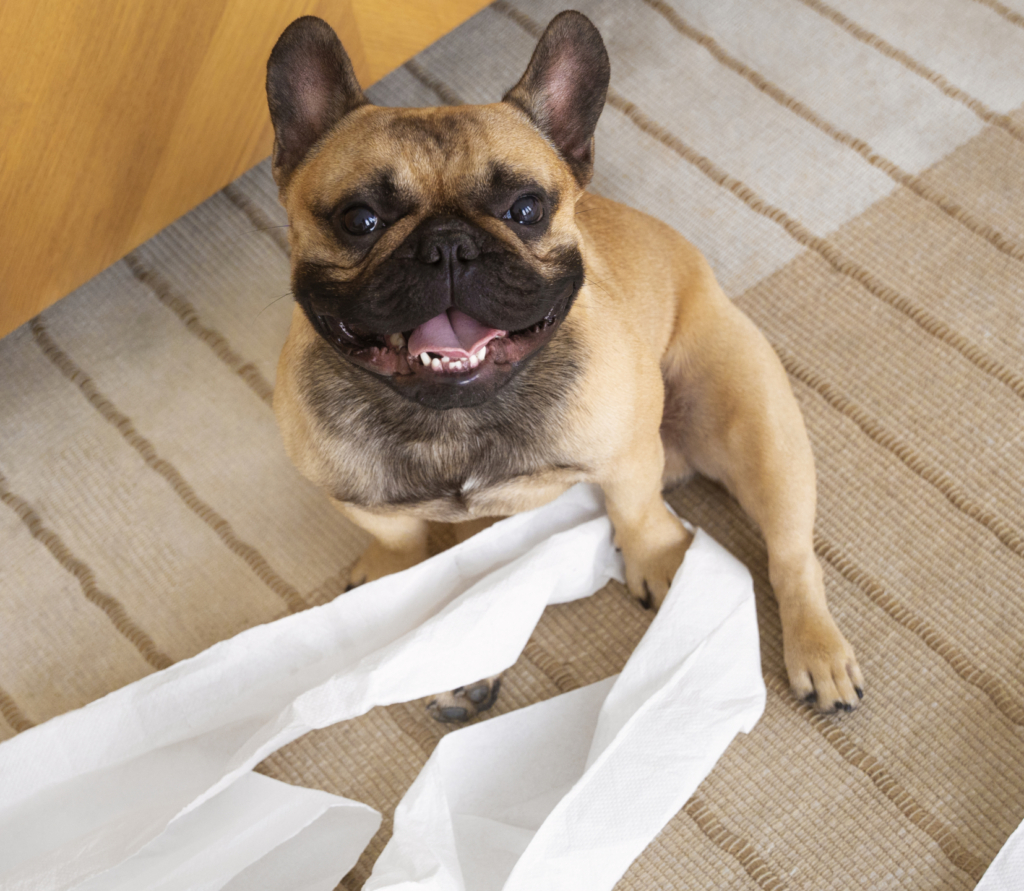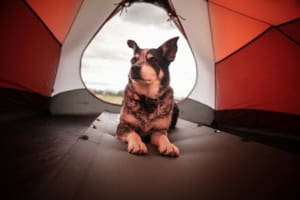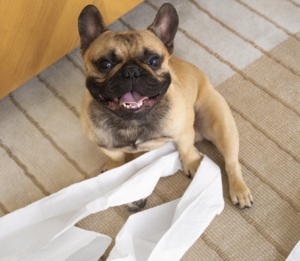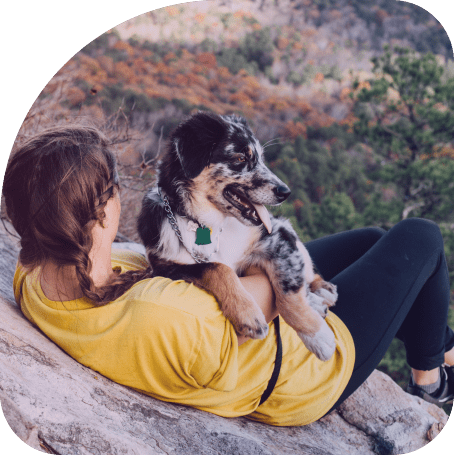If you haven’t read our first or second blog, head over there first before reading this one. Then, come back to learn more about:
- Regression periods
- Dogs that mark indoors
- Surfaces and different potty area options
- And some other common house training challenges
Remember, you are the biggest component to house training your dog. Being consistent, having a schedule, and using management strategies are the foundations to reaching your potty training goals!
Now, let’s get into it…
Regressions
Puppies almost always have a few regressions during the first year of their life. Just when you think they are fully house-trained, they may surprise you with an accident when you’re least expecting it. Don’t worry, this is very normal. Just keep an eye on them when this happens and spend a few days going back a few steps by taking them out more often and limiting their free-range time in the house. They should bounce back within a week to where they were.
Marking
Marking can also begin to happen, and it will feel like a regression. Marking is when our pups pee on something to leave their scent. Both female and male dogs mark, however, male dogs tend to get in trouble for it more often as they can be more prolific about it. If your dog is generally house trained but is clearly marking when indoors, likely, they are either going through some hormonal changes or there may be a medical issue going on. Either way, when visiting a pet store or a friend’s house for example, keep them on a leash, and by your side. If you need to take your eyes off of them then put them in a sit or down stay. Watch for indications that they are thinking about it, as there are always subtle warning signs. When you see it coming, say ‘uh-uh’ and take them directly outside. If this continues, a belly band can be a short-term indoor solution, and then be sure to speak to your vet to rule out any medical concerns.
Often getting a dog neutered can help stop the behaviour of excessive indoor marking. Or sometimes the dog needs some intensive management for a period of time (30-60 days) to curb a habit. This intensive management can look like staying on leash and tethered to you while indoors, crated, or only off leash or out of the crate when engaged with you and training or playing. Then straight outdoors to the bathroom. It is a very similar schedule for an untrained new puppy. They will grow out of this habit with strict supervision and no room for mistakes, if they don’t, speak to your vet to rule out any medical concerns. If they are in the habit of marking when indoors, just assume they’re going to do it and be proactive about your supervision and management. If they don’t improve after a couple of months, work with your vet, and/or a veterinarian behaviourist to see what else can be done.
Surfaces/Substrates
There are many different surfaces your dog might prefer to go to the bathroom on. These can include concrete, grass, carpets, gravel, sand, blankets, pee pads, litter boxes, or some dogs prefer to be in the bushes or even on top of bushes! This can vary depending on the dog and where the breeder had them going to the bathroom. Dogs develop a preference for which surface to relieve themselves on from their history of reinforcement. You want to choose your preferred surface and reinforce that from now on. If the surface is grass then only reinforce when your puppy goes to the bathroom on grass. Some dogs might take longer than others to transition. There is no right or wrong time. Keep in mind if you start with pee pads and want to transition outside, it will be more difficult as they have built up a reinforcement history with going to the bathroom indoors. But we also understand that in some circumstances, you might have no choice but to use pee pads.
There are many circumstances where it may feel necessary to put something on the ground for your pup to pee on while you are away or unable to supervise. No matter what you use, if it’s working, that’s great. We like to say that if it’s not a problem, then it’s not a problem!
As a warning, however, pups often end up eating whatever is on the ground and may get in the habit of eating the newspaper, cat litter or pee pads that you leave out for them to use. Additionally, by using an indoor spot, you will potentially delay your pup’s learning to go outside as they build the habit of going on the pads or newspaper indoors. That being said, many dogs start off peeing on newspaper or pee pads and still learn to go outside afterwards with great success. As long as they aren’t consuming the material you leave on the ground, and they are showing the capacity to still be able to go outside as well, then it’s completely fine and use whatever you need to.
When you are ready to transfer to a new surface or location, you’ll want to have your puppy on a leash, take them to the same place every time you think they have to go, add in your cue word, wait them out while holding their leash so they can’t go elsewhere, and reward generously and genuinely when your puppy has a success.
Some other house-training challenges:
Multi-goers: Some dogs will eliminate a few times in a row before they feel empty. If your dog is happily peeing outside, but then comes back inside and pees again, then take that as information that they may need to go a few times before they are actually done. After they have peed, wait a little bit longer for them to have the chance to go 1 or 2 more times. If your dog is peeing or pooping for what seems to be an excessive amount of times, it may be worth a trip to the vet or to have a critical look at their diet. Sometimes the cheaper the quality of food is, the more fibre in the food, the more processed the food is, or the more ingredients that are involved, the more they may have to eliminate, or it could be that they are having a reaction to the specific food they are eating and it is just not the right ingredients for them (not scientifically proven, just statements based on experience).
Excited-goers: A lot of puppies, and even some older dogs, will pee when they get really excited. An example would be when a human or animal they absolutely love greets them. For some dogs this could mean ANY person that even attempts to greet them, as some dogs are naturally hyper-social. This could be from adrenaline or could be from submission. Either way, rest assured that they typically grow out of it. The best way to help them is to stop people from initially greeting them for a couple of months. Ask anyone who approaches or enters the house to completely ignore them (no touching, no talking, no looking at them) until they are calm. This will help them learn that getting attention can be a calm experience. If this type of urination continues past puppyhood, it could be worth a visit to your veterinarian to make sure that it is nothing medical.
Inside-goers: This is when you have a pup that refuses to go to the bathroom outside, but then goes as soon as you get back inside. This is common for dogs that were not house-trained before they went to their new homes (often from bad breeding or rescued from an unfortunate situation). You can also see this with pups that were trained to use pee pads, newspaper or litter boxes. It is also common with fearful, anxious or very hyper dogs, as they are too distracted when outside, but as soon as they relax inside, they relieve themselves. Either way, if this is the case for your puppy or dog, then what you need to do is bring them straight into their crate upon returning to the house, and then after 2-5 minutes, bring them back outside for another chance to relieve themselves. And you may need to do this a few times in a row. Please refer to the “how to housetrain your puppy” section. What often happens is that your pup comes back inside and finally can relax. They then realize that they do, in fact, have to go to the bathroom. With consistency, they will learn that they simply will not be given the chance to go inside when you come back in, so it’s much more in their favour to go outside. It’s either this method or you wait them out, and that can take a long time!
On their property-only goers: For the dogs that won’t go to the bathroom when out and about but will only go once back at their property. This likely isn’t a house training issue, it is much more likely an anxiety issue. This will take time to help your dog feel safe and calm enough to relieve themselves when away from the safety of their home base. If this continues for a concerning amount of time, please do speak to your vet as there may be a bigger issue at play with their mental health.
——
If you and your pup are struggling to nail down house training, remember that we’re here to help. We know it can be overwhelming and frustrating to feel as though you’re not making progress, but remember that our dogs are always doing the best they can. Despite what you may think, or hear, dogs do not soil indoors to spite us, or as pay-back or revenge. They do it because it is all they know, they can’t help themselves (medical or habit or lack of bladder control), they somehow have a history of reinforcement around the behaviour or it is due to fear, anxiety or over-arousal. The fastest way to succeed is by being proactive and diligent with your management. Reach out to us for more information, advice or training – we’re here to help!



